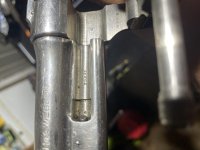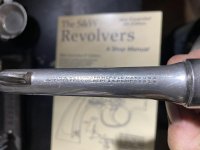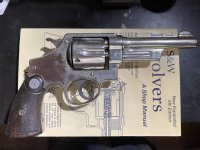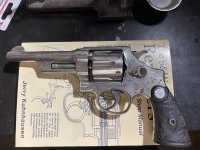How to fix a loose barrel without a gunsmith
It sounds like the barrel is loose in the frame and can rotate slightly either direction until it is stopped by the barrel pin. That is exactly the reason hand ejectors had the barrel pin, in case the barrel came loose! A lot of you won't understand or agree with this, but instead of having the barrel set back the simplest way to correct this problem is remove the barrel pin and unscrew the barrel completely. Then clean the barrel and frame threads with Loc-tite Klean 'n Prime, Once this is dry apply Green Loc-Tite Sleeve Retainer and screw the barrel back into the frame until it is positioned correctly, then allow the Loc-Tite to cure and re-install the barrel pin. This will be a permanent repair. This is how the factory installed the barrels in Airweight revolvers! Really!! I have removed and re-loc-tited Model 12 barrels this way and it is permanent and as strong as torque fitting the barrel. Removing Model 12 barrels is how I discovered this, the barrels had green Loc-Tite on the threads. Any Loc-Tite that squeezes out between the frame and barrel will not cure as it is an anaerobic resin. This can be easily wiped off once the resin in the barrel threads has completely cured after an hour or so.
Since the barrel is already loose it can be screwed in until properly indexed simply using your hands. You have to be quick because the Green Loc-Tite cures very quickly with the Klean 'n Prime, and you want to get it all the way in before the Loc-Tite begins to cure!
If you don't believe me then ask Roy Jinks about the Airweights. I have done several S&Ws, both Aluminum and steel framed, with loose barrels as I have described above and none of the barrels have ever come loose again!
Loc-Tite Sleeve Retainer is used in Automotive engine work to retain the valve guides in the cylinder heads and often cylinder liner sleeves in diesel engines so it is intended to take the heat and pressure of this application, which is every bit as strenuous as revolver barrels if not more. Retaining a revolver barrel is exactly the same as the originally intended use of this Loc-Tite product except the valve guides and cylinder liners aren't threaded, simply pressed in.
The only thing about this is the Klean 'n Prime and the Loc-Tite Sleeve Retainer are kind of pricey, probably about $50 total these days. Probably $250-$300 cheaper than a gunsmith would charge though. Regardless the gun should not be fired until the loose barrel problem is corrected.
The Loc-Tite Green Sleeve Retainer you want is the High Strength product, either #620 or #640. Brownells sells the #620 for about $18. If they don't have the Klean 'n Prime it can be obtained from many auto parts stores such as NAPA.




